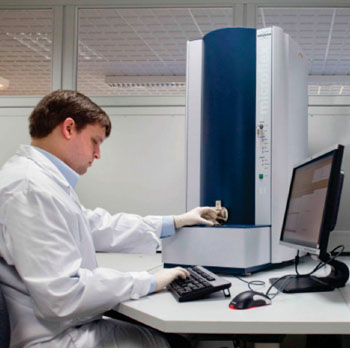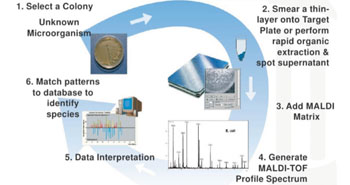Aerobic Bacteria Rapidly Identified by MALDI-TOF Mass Spectrometry
|
By LabMedica International staff writers Posted on 27 Jan 2016 |

Image: The Microflex LT bench-top MALDI-TOF mass spectrometer and BioTyper (Photo courtesy of Bruker Daltonics).

Image: Schematics of the Bruker MALDI BioTyper Workflow (Photo courtesy of Professor Melissa B. Miller).
Matrix-assisted laser desorption ionization time-of-flight mass spectrometry (MALDI-TOF MS) is a diagnostic tool for the identification of organisms routinely found in the microbiology laboratory.
MALDI-TOF MS has been proven to be a rapid and cost-effective diagnostic method for routine use in the clinical microbiology laboratory and MALDI-TOF MS technology uses ionizing laser for structural elements of the isolate to generate isolate-derived spectra, which is then compared to a reference database.
Scientists at the Children's Hospital Los Angeles (CA, USA) and their colleague at the Keck School of Medicine (Los Angeles, CA, USA) used isolates previously recovered by routine culture and workup from clinical specimens were cultured to appropriate media, identified directly by MALDI-TOF MS, and compared to results from various biochemical identification methods. A total of 996 aerobic Gram-positive and Gram-negative organism isolates were included in the study.
All MALDI-TOF MS testing was performed in duplicate with the same swab spotted onto two spots on the target plate, one spot representing a “heavy” inoculum and the second spot representing a “light” inoculum. Acquisition and analysis of mass spectra was performed using the Microflex LT mass spectrometer (Bruker Daltonics; Fremont, CA, USA). For media studies, 84 Gram-negative bacteria were cultured on blood agar, chocolate agar, and MacConkey agar; 74 Gram-positive bacteria were cultured on blood agar, chocolate agar, and colistin nalidixic acid (CNA) agar. For temperature and stability studies, four Gram-negative bacteria and four Gram-positive bacteria were cultured onto blood agar. Results of MALDI-TOF MS were compared to routine methods performed in the microbiology laboratory. All discordant identifications were confirmed by additional biochemical or 16S rRNA sequencing.
In MALDI-TOF MS data interpretation, a score of equal to or greater than 2.0 is equivocal to reliable species-level identification, a score of 1.7–1.99 is considered reliable to the genus level and a score of less than 1.7 is considered unreliable for bacteria identification. Using the direct-smear method, 99.5% and 98.0% of aerobic Gram-negative and Gram-positive bacteria, respectively, were identified to the genus level. At a score of equal to or greater than 1.9, 97.6% Gram-negative organisms and 94.6% Gram-positive organisms were correctly identified to the species level by direct-smear method. Only 1.1% of isolates required further reflex to direct-plate extraction. The direct-smear method proved to be robust, as various growth temperatures, media, culture age, and different operators had no notable impact on the bacterial identification rate.
The authors concluded that the direct-smear method was accurate and effective in streamlining the workflow of Gram-positive and Gram-negative bacterial identification in our clinical laboratory. For simplicity, they recommend using the direct-smear method for the majority of specimens commonly found in the clinical laboratory and an optimized spectral score cutoff of equal to or greater than 1.9 for enhanced species-level identification rates. The study was first published on December 14, 2015, in the Journal of Clinical Laboratory Analysis.
Related Links:
Children's Hospital Los Angeles
Keck School of Medicine
Bruker Daltonics
MALDI-TOF MS has been proven to be a rapid and cost-effective diagnostic method for routine use in the clinical microbiology laboratory and MALDI-TOF MS technology uses ionizing laser for structural elements of the isolate to generate isolate-derived spectra, which is then compared to a reference database.
Scientists at the Children's Hospital Los Angeles (CA, USA) and their colleague at the Keck School of Medicine (Los Angeles, CA, USA) used isolates previously recovered by routine culture and workup from clinical specimens were cultured to appropriate media, identified directly by MALDI-TOF MS, and compared to results from various biochemical identification methods. A total of 996 aerobic Gram-positive and Gram-negative organism isolates were included in the study.
All MALDI-TOF MS testing was performed in duplicate with the same swab spotted onto two spots on the target plate, one spot representing a “heavy” inoculum and the second spot representing a “light” inoculum. Acquisition and analysis of mass spectra was performed using the Microflex LT mass spectrometer (Bruker Daltonics; Fremont, CA, USA). For media studies, 84 Gram-negative bacteria were cultured on blood agar, chocolate agar, and MacConkey agar; 74 Gram-positive bacteria were cultured on blood agar, chocolate agar, and colistin nalidixic acid (CNA) agar. For temperature and stability studies, four Gram-negative bacteria and four Gram-positive bacteria were cultured onto blood agar. Results of MALDI-TOF MS were compared to routine methods performed in the microbiology laboratory. All discordant identifications were confirmed by additional biochemical or 16S rRNA sequencing.
In MALDI-TOF MS data interpretation, a score of equal to or greater than 2.0 is equivocal to reliable species-level identification, a score of 1.7–1.99 is considered reliable to the genus level and a score of less than 1.7 is considered unreliable for bacteria identification. Using the direct-smear method, 99.5% and 98.0% of aerobic Gram-negative and Gram-positive bacteria, respectively, were identified to the genus level. At a score of equal to or greater than 1.9, 97.6% Gram-negative organisms and 94.6% Gram-positive organisms were correctly identified to the species level by direct-smear method. Only 1.1% of isolates required further reflex to direct-plate extraction. The direct-smear method proved to be robust, as various growth temperatures, media, culture age, and different operators had no notable impact on the bacterial identification rate.
The authors concluded that the direct-smear method was accurate and effective in streamlining the workflow of Gram-positive and Gram-negative bacterial identification in our clinical laboratory. For simplicity, they recommend using the direct-smear method for the majority of specimens commonly found in the clinical laboratory and an optimized spectral score cutoff of equal to or greater than 1.9 for enhanced species-level identification rates. The study was first published on December 14, 2015, in the Journal of Clinical Laboratory Analysis.
Related Links:
Children's Hospital Los Angeles
Keck School of Medicine
Bruker Daltonics
Latest Microbiology News
- New AI-Based Method Improves Diagnosis of Drug-Resistant Infections
- Breakthrough Diagnostic Technology Identifies Bacterial Infections with Almost 100% Accuracy within Three Hours
- Innovative ID/AST System to Help Diagnose Infectious Diseases and Combat AMR
- Gastrointestinal Panel Delivers Rapid Detection of Five Common Bacterial Pathogens for Outpatient Use
- Rapid PCR Testing in ICU Improves Antibiotic Stewardship
- Unique Genetic Signature Predicts Drug Resistance in Bacteria
- Unique Barcoding System Tracks Pneumonia-Causing Bacteria as They Infect Blood Stream
- Rapid Sepsis Diagnostic Test Demonstrates Improved Patient Care and Cost Savings in Hospital Application
- Rapid Diagnostic System to Detect Neonatal Sepsis Within Hours
- Novel Test to Diagnose Bacterial Pneumonia Directly from Whole Blood
- Interferon-γ Release Assay Effective in Patients with COPD Complicated with Pulmonary Tuberculosis
- New Point of Care Tests to Help Reduce Overuse of Antibiotics
- 30-Minute Sepsis Test Differentiates Bacterial Infections, Viral Infections, and Noninfectious Disease
- CRISPR-TB Blood Test to Enable Early Disease Diagnosis and Public Screening
- Syndromic Panel Provides Fast Answers for Outpatient Diagnosis of Gastrointestinal Conditions
- Culture-Free Platform Rapidly Identifies Blood Stream Infections
Channels
Clinical Chemistry
view channel
Carbon Nanotubes Help Build Highly Accurate Sensors for Continuous Health Monitoring
Current sensors can measure various health indicators, such as blood glucose levels, in the body. However, there is a need to develop more accurate and sensitive sensor materials that can detect lower... Read more
Paper-Based Device Boosts HIV Test Accuracy from Dried Blood Samples
In regions where access to clinics for routine blood tests presents financial and logistical obstacles, HIV patients are increasingly able to collect and send a drop of blood using paper-based devices... Read moreMolecular Diagnostics
view channel
Novel Point-of-Care Technology Delivers Accurate HIV Results in Minutes
HIV diagnostic methods have traditionally relied on detecting HIV-specific antibodies, which typically appear weeks after infection. This delayed detection has hindered early diagnosis, complicating patient... Read more
Blood Test Rules Out Future Dementia Risk
Previous studies have suggested that specific biomarkers, such as tau217, Neurofilament Light (NfL), and Glial Fibrillary Acidic Protein (GFAP), may be valuable for early dementia diagnosis.... Read moreHematology
view channel
New Scoring System Predicts Risk of Developing Cancer from Common Blood Disorder
Clonal cytopenia of undetermined significance (CCUS) is a blood disorder commonly found in older adults, characterized by mutations in blood cells and a low blood count, but without any obvious cause or... Read more
Non-Invasive Prenatal Test for Fetal RhD Status Demonstrates 100% Accuracy
In the United States, approximately 15% of pregnant individuals are RhD-negative. However, in about 40% of these cases, the fetus is also RhD-negative, making the administration of RhoGAM unnecessary.... Read moreImmunology
view channel
Stem Cell Test Predicts Treatment Outcome for Patients with Platinum-Resistant Ovarian Cancer
Epithelial ovarian cancer frequently responds to chemotherapy initially, but eventually, the tumor develops resistance to the therapy, leading to regrowth. This resistance is partially due to the activation... Read more
Machine Learning-Enabled Blood Test Predicts Immunotherapy Response in Lymphoma Patients
Chimeric antigen receptor (CAR) T-cell therapy has emerged as one of the most promising recent developments in the treatment of blood cancers. However, over half of non-Hodgkin lymphoma (NHL) patients... Read morePathology
view channel
AI Model Predicts Patient Response to Bladder Cancer Treatment
Each year in the United States, around 81,000 new cases of bladder cancer are diagnosed, leading to approximately 17,000 deaths annually. Muscle-invasive bladder cancer (MIBC) is a severe form of bladder... Read more
New Laser-Based Method to Accelerate Cancer Diagnosis
Researchers have developed a method to improve cancer diagnostics and other diseases. Collagen, a key structural protein, plays various roles in cell activity. A novel multidisciplinary study published... Read more
New AI Model Predicts Gene Variants’ Effects on Specific Diseases
In recent years, artificial intelligence (AI) has greatly enhanced our ability to identify a vast number of genetic variants in increasingly larger populations. However, up to half of these variants are... Read more
Powerful AI Tool Diagnoses Coeliac Disease from Biopsy Images with Over 97% Accuracy
Coeliac disease is an autoimmune disorder triggered by the consumption of gluten, causing symptoms such as stomach cramps, diarrhea, skin rashes, weight loss, fatigue, and anemia. Due to the wide variation... Read moreTechnology
view channel
Innovative, Label-Free Ratiometric Fluorosensor Enables More Sensitive Viral RNA Detection
Viruses present a major global health risk, as demonstrated by recent pandemics, making early detection and identification essential for preventing new outbreaks. While traditional detection methods are... Read more
Smartphones Could Diagnose Diseases Using Infrared Scans
Rapid advancements in technology may soon make it possible for individuals to bypass invasive medical procedures by simply uploading a screenshot of their lab results from their phone directly to their doctor.... Read more
Novel Sensor Technology to Enable Early Diagnoses of Metabolic and Cardiovascular Disorders
Metabolites are critical compounds that fuel life's essential functions, playing a key role in producing energy, regulating cellular activities, and maintaining the balance of bodily systems.... Read more
3D Printing Breakthrough Enables Large Scale Development of Tiny Microfluidic Devices
Microfluidic devices are diagnostic systems capable of analyzing small volumes of materials with precision and speed. These devices are used in a variety of applications, including cancer cell analysis,... Read moreIndustry
view channel
Grifols and Tecan’s IBL Collaborate on Advanced Biomarker Panels
Grifols (Barcelona, Spain), one of the world’s leading producers of plasma-derived medicines and innovative diagnostic solutions, is expanding its offer in clinical diagnostics through a strategic partnership... Read more




















